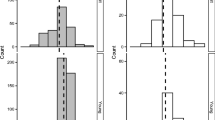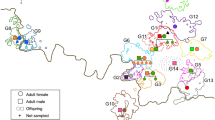Abstract
The social environment of many species includes synchronous maturation of siblings in family groups, followed by limited dispersal of adults from their natal site. Under these conditions, females may experience high encounter rates with same-age siblings during mate searching, increasing their risk of inbreeding. If inbreeding depression occurs, mating with a sibling is often considered maladaptive; however, in some contexts, the inclusive fitness benefits of inbreeding may outweigh the costs, favoring females that tolerate some level of inbreeding depression. We evaluated mating patterns in the treehopper Umbonia crassicornis, a semelparous species in which females encounter same-age siblings during mate searching. A female U. crassicornis that mates with a brother suffers from inbreeding depression. We used a free-choice mating design that offered females simultaneous mating opportunities with three groups of males: siblings, same-age nonsiblings, and older nonsiblings. These groups represent the types of males typically encountered by females during mate searching. Our goal was to assess whether mating patterns were influenced by inbreeding avoidance by evaluating two hypotheses: kin discrimination and age-based mating (older males cannot be siblings in this species). There was no difference in the proportions of females mating with siblings vs nonsiblings, suggesting an absence of kin discrimination. However, females mated with a greater proportion of older vs younger males. Given that females do not avoid siblings as mates despite a cost to inbreeding, our results provide a possible example of inbreeding tolerance. We also discuss some factors that may have contributed to the mating advantage of older males.


Similar content being viewed by others
References
Aviles L, Bukowski TC (2005) Group living and inbreeding depression in a subsocial spider. Proc R Soc Lond Ser B Biol Sci 273:157–163
Bateson P (1983a) Mate choice. Cambridge University Press, Cambridge
Bateson P (1983b) Optimal outbreeding. In: Bateson P (ed) Mate choice. Cambridge University Press, Cambridge, pp 257–278
Bateson M, Healy SD (2005) Comparative evaluation and its implications for mate choice. Trends Ecol Evol 20:659–664
Brooks R, Kemp DJ (2001) Can older males deliver the good genes? Trends Ecol Evol 16:308–313
Candolin U (2003) The use of multiple cues in mate choice. Biol Rev 78:575–595
Clutton-Brock TH, Albon SD (1979) The roaring of red deer and the evolution of honest advertisement. Behaviour 69:145–170
Cocroft RB (1996) Insect vibrational defence signals. Nature 382:679–680
Cocroft RB, McNett GD (2006) Vibrational communication in treehoppers (Hemiptera: Membracidae). In: Claridge MF, Drosopolous S (eds) Insect sounds and communication: physiology, behaviour, ecology and evolution. CRC, Boca Raton, pp 321–333
Conner J (1989) Older males have higher insemination success in a beetle. Anim Behav 38:503–509
Cote IM, Hunte W (1993) Female redlip blennies prefer older males. Anim Behav 46:203–205
Dickinson JL (2001) Extrapair copulations in western bluebirds (Salia mexicana): female receptivity favors older males. Behav Ecol Sociobiol 50:423–429
Felton A, Alford RA, Fenton AM, Schwarzkopf L (2006) Multiple mate choice criteria and the importance of age for male mating success in the microhylid frog, Cophixalus ornatus. Behav Ecol Sociobiol 59:786–795
Hasselquist D (1998) Polygyny in great reed warblers: a long term study of factors contributing to male fitness. Ecology 79:2376–2390
Hebets EA (2003) Subadult experience influences adult mate choice in an arthropod: exposed female wolf spiders prefer males of a familiar phenotype. Proc Natl Acad Sci USA 100:13390–13395
Hebets EA, Papaj DR (2005) Complex signal function: developing a framework for testable hypotheses. Behav Ecol Sociobiol 57:197–214
Jennions MD, Petrie M (1997) Variation in mate choice and mating preferences: a review of causes and consequences. Biol Rev 72:283–327
Jones TM, Elgar MA (2004) The role of male age, sperm age and mating history on fecundity and fertilization success in the hide beetle. Proc R Soc Lond Ser B Biol Sci 271:1311–1318
Jones TM, Balmford A, Quinnell RJ (2000) Adaptive female choice for middle-aged mates in a lekking sandfly. Proc R Soc Lond Ser B Biol Sci 267:681–686
Keller LF, Waller DM (2002) Inbreeding effects in wild populations. Trends Ecol Evol 17:230–241
Kemp DJ (2002) Butterfly contests and flight physiology: why do older males fight harder? Behav Ecol 13:456–461
Kendrick KM, Hinton MP, Atkins K, Haupt MA, Skinner JD (1998) Mothers determine sexual preferences. Nature 395:659–660
Kokko H (1997) Evolutionarily stable strategies of age-dependent sexual advertisement. Behav Ecol Sociobiol 41:99–107
Kokko H, Ots I (2006) When not to avoid inbreeding. Evolution 60:467–475
Lambin X, Aars J, Piertney SB (2001) Dispersal, intraspecific competition, kin competition and kin facilitation: a review of the empirical evidence. In: Clobert J, Danchin E, Dhondt AA, Nichols JD (eds) Dispersal. Oxford University Press, Oxford, pp 110–122
Le Boeuf BJ, Reiter J (1988) Lifetime reproductive success in northern elephant seals. In: Clutton-Brock TH (ed) Reproductive success. University of Chicago Press, Chicago, pp 344–362
Lihoreau M, Zimmer C, Rivault C (2007) Kin recognition and incest avoidance in a group-living insect. Behav Ecol 18:880–887
Marden JH, Wagge JK (1990) Escalated damselfly territorial contests are energetic wars of attrition. Anim Behav 39:954–959
Masters KL (1997) Behavioral and ecological aspects of inbreeding in natural animal populations: Inferences from Umbonia treehoppers (Homoptera: Membracidae). Ph.D. Princeton University, Princeton, p 311
McKamey SH, Deitz LL (1996) Generic revision of the New World tribe Hoplophorionini (Hemiptera: Membracidae: Mebracinae). Syst Entomol 21:295–342
Mead FW (1962) The thorn bug, Umbonia crassicornis (Amyot and Serville) (Homoptera: Membracidae). Florida Department of Agriculture, Division of Plant Industry, Tallahassee (Entomol Circ 8)
Mountjoy DJ, Lemon RE (1996) Female choice for song complexity in the European starling: a field experiment. Behav Ecol Sociobiol 65:65–71
Otronen M (1995) Energy reserves and mating success in males of the yellow dung fly, Scathophaga stercoraria. Funct Ecol 9:683–688
Palmer CA, Edmands S (2000) Mate choice in the face of both inbreeding and outbreeding depression in the intertidal copepod Tigriopus californicus. Mar Biol 136:693–698
Parker GA (1979) Sexual selection and sexual conflict. In: Blum MS, Blum NA (eds) Sexual selection and reproductive competition in insects. Academic, New York, pp 123–166
Plaistow SJ, Tsubaki Y (2000) A selective trade-off for territoriality and non-territoriality in the polymorphic damselfly Mnais costalis. Proc R Soc Lond Ser B Biol Sci 267:696–975
Proulx SR, Day T, Rowe L (2002) Older males signal more reliably. Proc R Soc Lond Ser B Biol Sci 269:2291–2299
Pusey A, Wolf M (1996) Inbreeding avoidance in animals. Trends Ecol Evol 11:201–206
Riechert SE, Roeloffs RM (1993) Evidence for and consequences of inbreeding in the cooperative spiders. In: Thornhill NW (ed) The natural history of inbreeding and outbreeding: Theoretical and empirical perspectives. The University of Chicago Press, Chicago, pp 283–303
Slagsvold T, Hansen BT, Johannessen LE, Lifjeld JT (2002) Mate choice and imprinting in birds studied by cross-fostering in the wild. Proc R Soc Lond Ser B Biol Sci 269:1449–1455
Srivastava S, Omkar (2004) Age-specific mating and reproductive senescence in the seven-spotted ladybird, Coccinella septempunctata. J Appl Entomol 128:452–458
Tallamy D, Schafer C (1997) Maternal care in the Hemiptera: Ancestry, alternatives, and current adaptive value. In: Choe JC, Crespi BJ (eds) The evolution of social behavior in insects and arachnids. Cambridge University Press, Cambridge, pp 94–115
Thornhill NW (1993) The natural history of inbreeding and outbreeding: Theoretical and empirical perspectives. The University of Chicago Press, Chicago
Uetz GW, Norton S (2007) Preference for male traits in female wolf spiders varies with the choice of available males, female age and reproductive state. Behav Ecol Sociobiol 61:631–641
Waldman B, McKinnon JS (1993) Inbreeding and outbreeding in fishes, amphibians, and reptiles. In: Thornhill NW (ed) The natural history of inbreeding and outbreeding: Theoretical and empirical perspectives. The University of Chicago Press, Chicago, pp 250–282
Windsor GL, Innes DJ (2002) Sexual reproduction in Daphnia pulex (Crustacea: Cladocera): observations on male mating behaviour and avoidance of inbreeding. Freshw Biol 47:441–450
Wong B, Candolin U (2005) How is female mate choice affected by male competition? Biol Rev 80:559–571
Wood TK (1974) Aggregating behavior of Umbonia crassicornis (Homoptera: Membracidae). Can Entomol 106:169–173
Wood TK (1976) Alarm behavior of brooding female Umbonia crassicornis (Homoptera: Membracidae). Ann Entomol Soc Am 69:340–344
Wood TK (1993) Diversity in the new world Membracidae. Annu Rev Entomol 38:409–435
Wood TK, Dowell R (1985) Reproductive behavior and dispersal in Umbonia crassicornis (Homoptera: Membracidae). Fla Entomol 68:151–158
Woodhead AP (1986) Male age: effect on mating behaviour and success in the cockroach Diploptera punctatai. Anim Behav 34:1874–1879
Zar JH (1984) Biostatistical analysis, 2nd edn. Prentice-Hall, New Jersey
Zuk M (1988) Parasite load, body size, and age of wild-caught male field crickets (Orthoptera: Gryllidae): effects of sexual selection. Evolution 42:969–976
Acknowledgments
We thank R. Snyder for help in designing and constructing the enclosure cages and B. Sonderman for help in maintaining the greenhouse population of U. crassicornis. We also thank L. Bussière, C. Gerhardt, D. Kemp, G. McNett, K. Ramaswamy, R. Rodríguez, J. Schul, R. Semlitsch, and two anonymous reviewers for their comments on the manuscript. M. Ellersieck of the University of Missouri, Department of Statistics, provided statistical advice. This research was supported by a Natural Sciences and Engineering Research Council (Canada) postgraduate scholarship to PAD. The experiments performed here comply with the current laws of the USA, the State of Missouri, and the guidelines of the University of Missouri-Columbia.
Author information
Authors and Affiliations
Corresponding author
Additional information
Communicated by L. W. Simmons
Rights and permissions
About this article
Cite this article
De Luca, P.A., Cocroft, R.B. The effects of age and relatedness on mating patterns in thornbug treehoppers: inbreeding avoidance or inbreeding tolerance?. Behav Ecol Sociobiol 62, 1869–1875 (2008). https://doi.org/10.1007/s00265-008-0616-2
Received:
Accepted:
Published:
Issue Date:
DOI: https://doi.org/10.1007/s00265-008-0616-2




